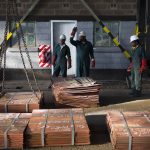Can Ramaphosa deal with the sector that ‘made’ him?
Many of SA’s environmental and economic problems stem from dependence on the minerals-energy complex. The president, being a beneficiary of this system, might not care to effect change.
Author:
4 October 2021

Gwede Mantashe, the Minister of Minerals and Energy, clearly lives in a fantasy land where coal is clean, where nuclear power is cheap and carbon-free and where R218 billion contracts for polluting fossil-fuel gas are the solution to South Africa’s energy and climate emergency challenges. Given this level of delusion, it is entirely right that pressure is mounting on him to adopt policies that actually address these challenges, rather than exacerbate them as his current policies do.
That said, it is important to remember that the minister has a boss, a person to whom he is answerable and who is ultimately responsible for the policies that he pursues. That person is, of course, President Cyril Ramaphosa.
In stark contrast to the utterances of his minister, the president says all the right things about the climate emergency. Just two years ago, he told the United Nations Climate Summit that South Africa recognises the seriousness of the climate emergency, that it needs urgently to reduce its dependence on fossil fuels and to take advantage of the “massive opportunity” that a Just Transition to renewable energy promises.
Related article:
He has followed this up, in his last two state of the nation addresses and in some of his weekly newsletters, with references to “the pressing need to address the climate emergency”. To give substance to these words, the Presidential Climate Commission has been established and has met several times this year, while the Climate Change Bill awaits his signature.
On the face of it, we seem to have a rogue coal-and-mining fundamentalist minister who appears to be following an entirely different script to that of the president. But is this apparent dissonance real? Do the president and his minister really hold such opposing views on South Africa’s energy and climate futures? To answer these questions, we need to delve into the past, into South Africa’s history and into Ramaphosa’s personal history.
Age-old accumulation
In their 1997 book, The Political Economy of South Africa, economists Ben Fine and Zavareh Rustomjee coined the phrase “the minerals-energy complex” to describe the dominant role that mining and energy production have on the South African economy – both in terms of their direct economic impacts and their “determining role throughout the rest of the economy”. In particular, they draw attention to how historical patterns of ownership, economic activity and political expediency created the conditions whereby the state and private mining interests became integrated (via institutions such as the Chamber of Mines) into what they describe as a “system of accumulation”.
It is a system characterised by an energy apparatus that was skewed towards the mining sector as a site of accumulation. It is a system, they posit, that “has exercised a profound influence upon socio-economic and political life more generally” in South Africa.
While the influence that the minerals-energy complex wields in South Africa has gradually eroded due to mineral depletion and overseas competition, it nonetheless remains a powerful economic and political force in the country. This is because the transition to democracy in 1994 did not see a break in the dominant position of white private capital. Also, this capital successfully co-opted members of the new political elite into its fold. This was particularly so in the mining sector where the mingling of state and private interests continued to create the conditions for the ongoing “system of accumulation”.
Related article:
By this process, new Randlords emerged in post-apartheid South Africa, such as Patrice Motsepe of African Rainbow Minerals and Cyril Ramaphosa of Shanduka, among others. It is a Black political and business elite that was accommodated by white capital. This process continues in one form or another to this day, whereby significant elements within the political elite in South Africa retain substantial economic interests in the mining sector.
Let us not forget, for example, that Motsepe is Ramaphosa’s brother-in-law, while Bridgette Radebe of Mmakau Mining is Motsepe’s sister and is married to former energy minister Jeff Radebe. Numerous similar linkages exist between former members of government and the mining sector.
What this history clearly reveals is that Mantashe’s support for coal mining and mining in general is not an aberration, because the system of accumulation that exists between South Africa’s political elite and mining still runs very deeply. As such, significant elements within the political elite have much to lose from a rejection of coal mining and a more wholesale rejection of extractivism (oil, gas and more) in the interests of confronting the climate emergency.
Handmaiden or reformer
What all this means for Ramaphosa is less clear. At present he seems to be trying to juggle powerful elements within the ANC who remain intensely committed to extractivism with other elements within the party that understand that extractivism is not compatible with the ongoing and deepening climate emergency. As such, the president stands at a crossroads, one which provides him with an opportunity to reflect on his legacy.
Related article:
Does he want to be remembered solely as handmaiden to the mining industry, implicated as he is in South Africa’s darkest post-apartheid moment, the murder of 34 miners at Marikana, or does he want to be remembered for more than that?
Can he also be remembered as the president who took the bold step to break with over 100 years of history and, in the interests of a just transition and planetary health, rejected South Africa’s dirty history of extractivism? History will be the judge.



